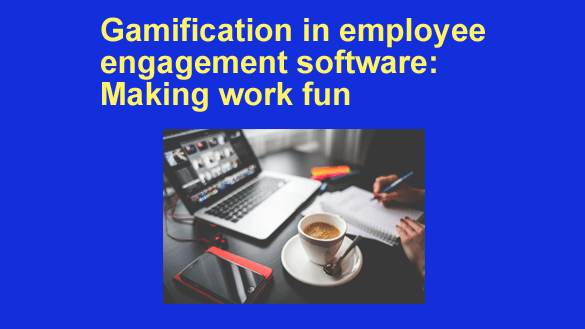 Employee engagement has become a focus for companies aiming to enhance productivity and retain talent in today’s fast-paced and data-driven business world.
Employee engagement has become a focus for companies aiming to enhance productivity and retain talent in today’s fast-paced and data-driven business world.
One innovative solution that has gained popularity recently is the incorporation of gamification into employee engagement software.
By integrating game elements and mechanics into the work environment, companies are discovering ways to motivate and inspire their employees.
What is Gamification?
It involves applying principles and mechanics commonly found in games to gaming contexts, such as the workplace.
This approach aims to create an enjoyable experience by introducing elements like points, badges, leaderboards, and rewards into everyday tasks and activities. The ultimate goal is to tap into the desire for competition, achievement, and social recognition to drive employee motivation and performance.
How does Gamification Work within Employee Engagement Software?
Typically, it entails utilizing a platform or app created by employee engagement solution companies that seamlessly integrates with existing tools and systems. Employees can earn points or badges by completing tasks or achieving predetermined goals.
These accomplishments can be showcased on leaderboards or shared with colleagues for added recognition. Apart from rewards, companies can also provide incentives like gift cards or additional vacation days to maintain employee motivation.
Benefits of incorporating gamification in the workplace
1 – Improved Motivation and Engagement
Introducing game-like elements encourages employees to stay motivated and engaged in their work. The element of competition and the drive to earn rewards can inspire employees to surpass expectations in their tasks and responsibilities.
2 – Enhanced Productivity and Performance
Engaged and motivated employees tend to be more productive and perform at a level. Gamification helps create a sense of purpose and challenge, motivating employees to take on responsibilities and strive towards achieving their goals.
3 – Improved Development
Gamification is particularly beneficial for training and development programs. By transforming learning into a game, employees are more likely to retain information and participate in training initiatives by transforming learning into a game. It can lead to enhanced skills and knowledge organization-wide.
4 – Increased Collaboration and Teamwork
Many gamified platforms include features that enable employees to compete with each other while also fostering collaboration. It cultivates a sense of teamwork as employees work together towards shared objectives, aiming for success while earning rewards along with work anniversary celebration.
5 – Real-time Feedback and Recognition
Incorporating gamification into employee engagement software offers the advantage of providing employees recognition with feedback on their performance. It enables them to gauge their progress and make any adjustments as they go along.
Furthermore, displaying achievements on leaderboards and acknowledging and rewarding employees for their efforts can significantly boost morale and foster a work environment.
Implementing Gamification in Employee Engagement Software
While the benefits of gamification are evident, successfully implementing it requires planning and execution. Here are some important factors for companies to consider when integrating gamification into their employee engagement strategy.
1 – Clearly Define Objectives
Before launching any gamification program, it is crucial to establish objectives and goals. What do you aim to achieve through gamification? How will it support these objectives? Having a defined vision will guide the design and implementation process effectively.
2 – Select the Platform
Several gamification platforms are available, each with its features and capabilities. Thoroughly research options to choose a platform that aligns with your company’s needs and goals. Factors such as user-friendliness, customization options, and integration capabilities should be considered.
3 – Ensure Alignment with Company Culture and Values
It is essential to ensure that the gamification program aligns seamlessly with your company’s culture and values.
Ensure that the game elements and mechanics are relevant and meaningful to your employees and their work responsibilities.
4 – Offer Rewards that Hold Value
While virtual rewards can be motivating, it’s equally important to provide rewards that hold significance in order to keep employees engaged. This could include gift cards, time off, or incentives that align with your employees’ preferences and interests.
5 – Continuously Iterate and Improve
Implementing gamification is not a one-time task; it requires monitoring and adjustments. Regularly assess the effectiveness of the program. Gather feedback from employees to identify areas for enhancement. Utilize this feedback to enhance the gamification program, keeping it fresh and captivating.
Conclusion
In conclusion, integrating gamification into employee engagement software effectively motivates and engages employees within their settings. Organizations can cultivate an enjoyable work environment by tapping into individuals’ inherent drive for competition and accomplishment.
Through planning and execution, gamification can bolster productivity levels and collaboration among teams as well as enhance overall employee satisfaction. So, why not infuse work with some fun? Give gamification a try today, witnessing its impact on your organization.